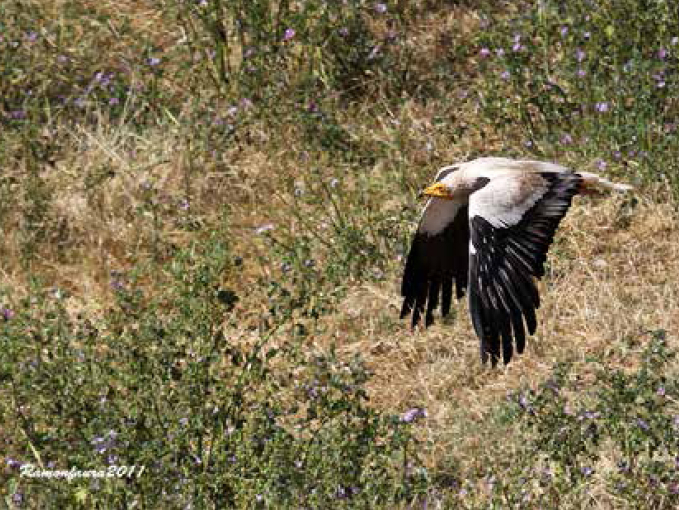|
The Egyptian Vulture: a species coming back to Eastern Catalonia
Report extracted from ‘El Picot negre’,
num. 24, December 2014, the news magazine of the Cadí-Moixeró Natural
Park. Authors: Joan Real (Conservation Biology Group - UB), Helena
Tauler (Conservation Biology Group - UB) and Jordi Baucells (Grup de Naturalistes d’Osona).

|
|
The Egyptian Vulture (Neophron percnopterus),
with a wingspan of 165 cm, is the smallest of the vulture species found
in Europe. It is white with yellow face and legs, and it is easily
identified on flight by the contrast between the white body and tail
with the black flight feathers.
This is quite a generalist scavenger species, since it is able to take
any resource found available. It patrols its territory searching for
scraps of livestock, as well as wild medium or small size animals,
being mammals, birds or reptiles.
|
Egyptian Vulture in flight.
Photo: Ramon Faura Cunill
|
|
The
Egyptian Vulture is a trans-Saharan migrant species, which means that
it winters in Sub-Saharian Africa from September to February. Pairs
breeding in Catalonia begin to arrive on March and, once the chicks
fledge, they go back to Africa. They nest in cliffs and rocky areas of
mid-mountains, using caves and natural platforms to take shelter and
build the nest. The nest is usually located near open areas and human
settlements, where they look for food. It is a territorial species, so
nests of different pairs are usually separated at least 1-5 km.

|
|
This
species is found from Asia to the Middle East, the Mediterranean area
and some areas South of the Sahara Desert, as well as some Atlantic
isles such as the Canary Islands. This species is globally considered
‘Endangered’ by scientists, due to its populations became extinct or
undergone fairly general decline in most of its former distribution.
The Iberian Peninsula holds one of the most numerous populations in the
World, but it declined a 25% between 1987 and 2000. For this reason, it
is also considered ‘Endangered’ in Spain and it is included in the
Annex I of the Birds Directive.
In Catalonia, this species suffered a deep decline during the 60s and
the 70s and in Eastern Catalonia (counties of Ripollès, Garrotxa and
Berguedà) it became almost extinct. This trend changed during the 80s,
when the Egyptian Vulture recolonized old territories, leading to an
increase in the number of breeding pairs. This spread in Catalonia
occurred in a context of important recent changes in human activities,
such as the increase in urban and livestock waste (landfills),
landscape changes (semi-extensive livestock, wildfires), and social
changes (increase in consciousness about conservation issues).
|
Egyptian Vulture adult.
Photo: Ramon Faura Cunill
|
|
In order to study the spread of
this species in Catalonia, the Conservation Biology Group of the
University of Barcelona, the Grup de Naturalistes d’Osona (a
naturalists’ association) and naturalists from the Berguedà county
began a cooperate monitoring of the population of Egyptian Vulture in
centre and Eastern Catalonia, supported by different natural parks
(Sant Llorenç del Munt, Montserrat, Zona Volcànica de la Garrotxa and
Cadí-Moixeró). The main target of this monitoring is to know the
population status in this area, its evolution and the factors affecting
this increase.

|
| Tasks
conducted in this study consisted on a census of occupied territories,
obtaining the reproductive rates of this population, ringing the chicks
and studying their physical condition and diet. The aim of this census
was to know the demographic evolution of this population and to study
its long-term viability, as well as to analyse environmental and
ecological factors affecting this increase. The analysis of the chicks’
physical condition and diet will allow to know the role of the human
activities (livestock, landfills...) and their influence on the
survival and health condition of the chicks. Finally, the chicks
ringing will allow to get information on their movements and survival,
as well as to know if they come back to the areas where they were born,
what helps to increase this population.
|
Ringing an Egyptian Vulture chick.
Photo: Kiku Parés
|
|
|
In 2014, 23 territories were
monitored, of which 19 pairs succeeded in rearing at least one fledge
chick, while 4 territories did not breed or failed in their breeding
attempts. 7 of these territories monitored were located within the
Berguedà county and 5 chicks were fledged.
Some of the most relevant threats affecting this species are
disturbances within the breeding areas, in some cases due to the
presence of paragliders taking off near the nests, or in other cases
due to the presence of climbers or nearby buildings. It is still not
known why some pairs fail repeatedly in their breeding attempts. In the
future, it is posed to continue monitoring the population in order to
know its evolution and to study its dependence with some new land uses
(livestock, landfills...), as well as to study factors affecting its
conservation.
The monitoring of the territories, ringing of the chicks and other
tasks were possible tanks to the collaboration of several naturalists,
technicians and natural parks rangers, like P. Aymerich, J. Bermejo, J.
Fort, P. I. Isern, G. de Jesús, J. Santandreu, J. Calaf, G. Lampreave,
T. Mampel, A. Peris and J. Montserrat. We would like to thank the
support received from different natural parks (Cadí-Moixeró,
Montserrat, Sant Llorenç del Munt, Zona Volcànica de la Garrotxa and
Consorci dels Espais Naturals del Ripollès), and the collaboration of
the the Cos d'Agents Rurals and particularly the Grup de Suport de
Muntanya. The Biodiversity Service of the Catalan Government also gave
support and authorized the research tasks. Finally, we would also like
to thank the Catalan Ornithological Institute
for giving support to this project. Once again, all this is an example
of multipart collaboration that allows synergies to help an endangered
species.
|




